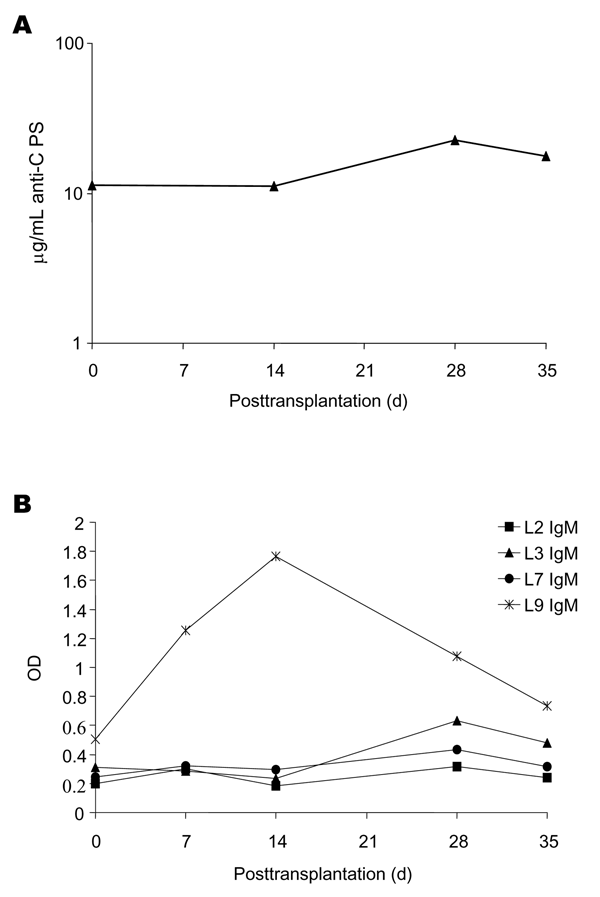Volume 11, Number 8—August 2005
Letter
Neisseria meningitidis Endotoxin and Capsule Transmission by Transplantation
Figure

Figure. . Pre- and posttransplantation serum antibodies as measured by enzyme-linked immunosorbent assay (ELISA). A) Immunoglobulin (Ig) G antibodies to Neisseria meningitidis serogroup C capsular polysaccharide (CPS) determined as described by Arakere and Frasch (7) with minor modifications. Samples were run in duplicate at 8 serial dilutions, and antibody concentrations were calculated relative to the standard reference serum lot CDC 1992 (courtesy of G. Carlone, Centers for Disease Control and Prevention, Atlanta, GA). B) IgM antibodies to N. meningitidis lipooligosaccharide (LOS) immunotypes (L2, L3, L7, L9). ELISA to detect antibodies to LOS immunotypes L2, L3, L7, or L9 was performed as described (8), with minor modifications, by using goat antihuman IgG (γ-specific, Kirkegaard & Perry, Gaithersburg, MD, USA) or goat antihuman IgM (μ-specific, Sigma, St. Louis, MO, USA) conjugated to alkaline phosphatase. Samples were run in duplicate at 4 serial dilutions. OD, optical density.
References
- Loinaz C, Moreno Gonzalez E. Marginal donors in liver transplantation. Hepatogastroenterology. 2000;47:256–63.PubMedGoogle Scholar
- Lopez-Navidad A, Domingo P, Cabellero F, Gonzalez C, Santiago C. Successful transplantation of organs retrieved from donors with bacterial meningitis. Transplantation. 1997;64:365–8. DOIPubMedGoogle Scholar
- Satoi S, Bramhall SR, Solomon M, Hastings M, Mayer AD, De Goyet JV, The use of liver grafts from donors with bacterial meningitis. Transplantation. 2001;72:1108–13. DOIPubMedGoogle Scholar
- Nery JR, Weppler D, Ketchum P, Olson L, Fragulidis GP, Khan MF, Donor infection and primary nonfunction in liver transplantation. Transplant Proc. 1997;29:481–3. DOIPubMedGoogle Scholar
- Yokoyama I, Todo S, Miyata T, Selby R, Tzakis AG, Starzi TE. Endotoxemia and human liver transplantation. Transplant Proc. 1989;21:3833–41.PubMedGoogle Scholar
- Campbell JD, Edelman R, King JC Jr, Papa T, Ryall R, Rennels MB. Safety, reactogenicity, and immunogenicity of a tetravalent meningococcal polysaccharide-diphtheria toxoid conjugate vaccine given to healthy adults. J Infect Dis. 2002;186:1848–51. DOIPubMedGoogle Scholar
- Arakere G, Frasch CE. Specificity of antibodies to O-acetyl-positive and O-acetyl-negative group C meningococcal polysaccharides in sera from vaccinees and carriers. Infect Immun. 1991;59:4349–56.PubMedGoogle Scholar
- Tsai CM, Civin CI. Eight lipooligoshaccharides of Neisseria meningitidis react with a monoclonal antibody which binds lacto-N-neotetraose (GalB1-4GlcNAcB1-3GalB1-4Glc). Infect Immun. 1991;59:3604–9.PubMedGoogle Scholar
- Brandtaeg P, Kierulf P, Gaustad P, Skulberg A, Brunn J, Halvorse S, Plasma endotxoin as a predictor of multiple organ failure and death in systemic meningococcal disease. J Infect Dis. 1989;159:195–204. DOIPubMedGoogle Scholar
- Zipfel A, Schenk M, You M-S, Lauchart W, Bode C, Viebahn R. Endotoxemia in organ donors: graft function following liver transplantation. Transpl Int. 2000;13(Suppl 1):S286–7.